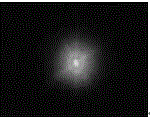Light scattering thermoplastic polyester composition
A composition and light-scattering technology, applied in the field of light-scattering polyester resin compositions, can solve the problems of unfavorable light-scattering performance stability, energy waste, sensitivity, etc., achieve good appearance and light stability, excellent light-scattering performance, raw materials A wide range of effects
- Summary
- Abstract
- Description
- Claims
- Application Information
AI Technical Summary
Problems solved by technology
Method used
Image
Examples
Embodiment 1
[0050] 100 parts by mass of polymethyl methacrylate resin, 2 parts by mass of polyethylene terephthalate and conventional additives were melt-blended by a torque rheometer to obtain a light-scattering polyester resin composition. The composite was compression-molded at 265°C to prepare a 0.60 mm thick light-scattering sheet. The light transmittance was measured to be 77.5%, and the haze was 88.90%. After the point light source passes through the light scattering sheet, the scattering effect is as follows: figure 2 shown.
Embodiment 2
[0052] 100 parts by mass of polymethyl methacrylate resin, 6 parts by mass of polyethylene terephthalate and conventional additives were melt-blended by a torque rheometer to obtain a light-scattering polyester resin composition. The composite was compression-molded at 265°C to prepare a 0.60 mm thick light-scattering sheet. The measured light transmittance is 64.2%, and the haze is 94.41%. After the point light source passes through the light scattering sheet, the scattering effect is as follows: image 3 shown.
Embodiment 3
[0054] 100 parts by mass of polymethyl methacrylate resin, 10 parts by mass of polyethylene terephthalate and conventional additives were melt-blended by a torque rheometer to obtain a light-scattering polyester resin composition. The composite was compression-molded at 265°C to prepare a 0.60 mm thick light-scattering sheet. The measured light transmittance is 58.9%, and the haze is 94.65%. After the point light source passes through the light scattering sheet, the scattering effect is as follows: Figure 4 shown.
PUM
 Login to View More
Login to View More Abstract
Description
Claims
Application Information
 Login to View More
Login to View More - R&D Engineer
- R&D Manager
- IP Professional
- Industry Leading Data Capabilities
- Powerful AI technology
- Patent DNA Extraction
Browse by: Latest US Patents, China's latest patents, Technical Efficacy Thesaurus, Application Domain, Technology Topic, Popular Technical Reports.
© 2024 PatSnap. All rights reserved.Legal|Privacy policy|Modern Slavery Act Transparency Statement|Sitemap|About US| Contact US: help@patsnap.com










